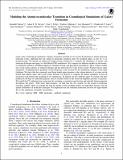| dc.contributor.author | Diemer, Benedikt | |
| dc.contributor.author | Stevens, Adam RH | |
| dc.contributor.author | Forbes, John C | |
| dc.contributor.author | Marinacci, Federico | |
| dc.contributor.author | Hernquist, Lars | |
| dc.contributor.author | Lagos, Claudia del P | |
| dc.contributor.author | Sternberg, Amiel | |
| dc.contributor.author | Pillepich, Annalisa | |
| dc.contributor.author | Nelson, Dylan | |
| dc.contributor.author | Popping, Gergö | |
| dc.contributor.author | Villaescusa-Navarro, Francisco | |
| dc.contributor.author | Torrey, Paul | |
| dc.contributor.author | Vogelsberger, Mark | |
| dc.date.accessioned | 2021-10-27T20:35:06Z | |
| dc.date.available | 2021-10-27T20:35:06Z | |
| dc.date.issued | 2018 | |
| dc.identifier.uri | https://hdl.handle.net/1721.1/136377 | |
| dc.description.abstract | © 2018. The American Astronomical Society. All rights reserved.. Large-scale cosmological simulations of galaxy formation currently do not resolve the densities at which molecular hydrogen forms, implying that the atomic-to-molecular transition must be modeled either on the fly or in postprocessing. We present an improved postprocessing framework to estimate the abundance of atomic and molecular hydrogen and apply it to the IllustrisTNG simulations. We compare five different models for the atomic-to-molecular transition, including empirical, simulation-based, and theoretical prescriptions. Most of these models rely on the surface density of neutral hydrogen and the ultraviolet (UV) flux in the Lyman-Werner band as input parameters. Computing these quantities on the kiloparsec scale resolved by the simulations emerges as the main challenge. We show that the commonly used Jeans length approximation to the column density of a system can be biased and exhibits large cell-to-cell scatter. Instead, we propose to compute all surface quantities in face-on projections and perform the modeling in two dimensions. In general, the two methods agree on average, but their predictions diverge for individual galaxies and for models based on the observed midplane pressure of galaxies. We model the UV radiation from young stars by assuming a constant escape fraction and optically thin propagation throughout the galaxy. With these improvements, we find that the five models for the atomic-to-molecular transition roughly agree on average but that the details of the modeling matter for individual galaxies and the spatial distribution of molecular hydrogen. We emphasize that the estimated molecular fractions are approximate due to the significant systematic uncertainties. | |
| dc.language.iso | en | |
| dc.publisher | American Astronomical Society | |
| dc.relation.isversionof | 10.3847/1538-4365/AAE387 | |
| dc.rights | Article is made available in accordance with the publisher's policy and may be subject to US copyright law. Please refer to the publisher's site for terms of use. | |
| dc.source | The Astrophysical Journal | |
| dc.title | Modeling the Atomic-to-molecular Transition in Cosmological Simulations of Galaxy Formation | |
| dc.type | Article | |
| dc.contributor.department | Massachusetts Institute of Technology. Department of Physics | |
| dc.contributor.department | MIT Kavli Institute for Astrophysics and Space Research | |
| dc.relation.journal | The Astrophysical Journal Supplement Series | |
| dc.eprint.version | Final published version | |
| dc.type.uri | http://purl.org/eprint/type/JournalArticle | |
| eprint.status | http://purl.org/eprint/status/PeerReviewed | |
| dc.date.updated | 2019-04-26T19:24:04Z | |
| dspace.orderedauthors | Diemer, B; Stevens, ARH; Forbes, JC; Marinacci, F; Hernquist, L; Lagos, CDP; Sternberg, A; Pillepich, A; Nelson, D; Popping, G; Villaescusa-Navarro, F; Torrey, P; Vogelsberger, M | |
| dspace.date.submission | 2019-04-26T19:24:05Z | |
| mit.journal.volume | 238 | |
| mit.journal.issue | 2 | |
| mit.metadata.status | Authority Work and Publication Information Needed | |
